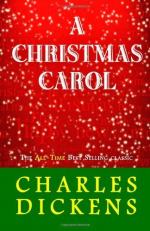|
|
A Christmas Carol Author/Context
Charles Dickens was born in England on February 7, 1812. He was the second of eight children, and his father was a clerk in the Navy Pay Office. As a child, Dickens' health was frail and his education was random. His mother taught him his letters and Dickens read a great deal from his father's library of the classics of fiction. The boy was also interested in theater and his first written work was a tragedy. At the age of nine, he was schooled with a neighbor's child, and when his father was transferred to London, Dickens stayed behind for a while in Chatham for his schooling. But when he rejoined his family in London, dark days awaited him.
His father was in debt, and so the Dickens family resided with him in Marshalsea Prison. Charles found work at household tasks and took a room for himself on one of the poor streets of London at the age of twelve. He worked for a while labeling blacking-bottles until his father inherited a legacy that brought the family out of debt again. Dickens was sent to school for a few more years before he became a clerk. He moved up from there to become a stenographer at several newspapers.
In 1833 his first published piece appeared in the Monthly Magazine signed with his brother's nickname. He later published a few pieces in the Evening Chronicle before the Pickwick Papers made him famous. For the next thirty years Dickens churned out novels until he died. His other works include: Life and Adventures of Nicholas Nickleby (1839), The Personal History of David Copperfield (1850), Little Dorrit (1857), A Tale of Two Cities (1859), and Great Expectations (1861).
Dickens had a large family with his wife, Catherine Hogarth, and he became a wealthy man through his writing. Dickens wrote actively while acting in private theatricals as well as touring and performing readings of his works.
In 1865, Dickens had a slight stroke that left his legs useless, but even this break in his health did not deter him from his active lifestyle of travel and work. He was working on The Mystery of Edwin Drood the day before he died. He was stricken with apoplexy and died the next day. Dickens was buried in Westminster Abbey.
Although Dickens has been criticized for creating characters which seem more like caricatures than real people, Ebenezer Scrooge and other Dickens figures have become well known in literature. A Christmas Carol expresses the far-reaching impact of Dickens' work in its ability to transcend the boundaries of the time in which it was written and remain a popular piece of drama and literature more than a century after it was first published in 1836.
"Dickens . . . [was] the greatest dramatic writer that the English had had since Shakespeare, and . . . we may find in Dickens' work today a complexity and . . . an intellectual and artistic interest which makes Dickens loom very large in the whole perspective of the literature of the West."
Bibliography
Dickens, Charles. "A Christmas Carol." Best Ghost Stories. Hertfordshire, England: Wordsworth Editions Limited, 1997.
"Dickens, Charles." Biographical Dictionary. New York: Chambers Harrap Publishers Ltd., 1997.
"Dickens, Charles." British Writers. ed. Ian Scott-Kilvert. vol. 5. New York: Charles Scribner's Sons, 1982.
Wilson, Edmund. "Dickens, Charles." World Literature Criticism: 1500 to present. ed. James P. Draper. vol. 2. Detroit: Gale Research Inc., 1992.




